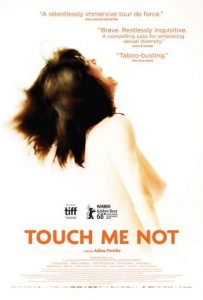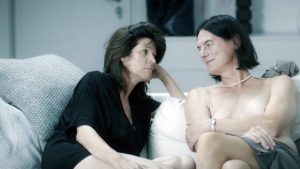 Filmofil.ba proudly represents the works of young critics done in program Talents Sarajevo of 24th Sarajevo Film Festival
Filmofil.ba proudly represents the works of young critics done in program Talents Sarajevo of 24th Sarajevo Film Festival
Written by: Nadina Štefančič
Romanian director Adina Pintilie’s first feature TOUCH ME NOT (2018) won the Golden Bear at Berlinale, which is not a surprise, since it could not have arrived at a better time. It is part of a long-time-coming film movement, ranging from Hollywood to European creative docs – a demand of a new female gaze. Mass audiences experienced it in Lena Dunham’s GIRLS, Amy Schumer’s comedies, as well as other female-directed film and TV works that have taken over the big and small screen in recent years. Pintilie takes it a step further, however. Rather than turning to humor or any kind of genre, she breaks the patterns and lets the body lead the way.
TOUCH ME NOT has a polyamorous relationship with its form, loving a drama film, a creative documentary, an observatory documentary, a pseudo-documentary, a meta-deconstruction of what film is – all with the same intensity. It creates a hybrid made out of pure excitement about what film can do with its tools, including a cameo of these tools with close-ups of a camera. In there lives the writer-director Pintilie, observing her lead female character, the 50-year-old Laura (Laura Benson), asking questions they both fail to answer, amongst which the most persistent one includes: “What is this film about?”
 Laura seems to be a film-relative of Erika Kohut from Michael Haneke’s THE PIANO TEACHER / LA PIANISTE (2001) – a woman who holds no answers and cannot stand her body. For Laura, having an audience on her sickens her, a touch disables her. In search of relieving the tension from her body, she turns to a diverse group of people who are not only psychologically or emotionally disabled but have a “distinct” body disability. With this physical deviation from the normal, they are unable to avoid our gaze; yet, in this group, it is the physically challenged who teach the emotionally or psychologically challenged to trust again. The clinical laboratory, in which they are placed, is a white, sterile, “untouched” environment, as is the majority of the film’s visuals. The dead-cold whiteness of the scenography and costumography is interrupted by the loud, noisy music of the Berlin-based band Einstürzende Neubauten, Laura’s painful screams when touched, as well as scenes from an extravagant S&M underground club – an environment as controlled and therapeutic as the clinic.
Laura seems to be a film-relative of Erika Kohut from Michael Haneke’s THE PIANO TEACHER / LA PIANISTE (2001) – a woman who holds no answers and cannot stand her body. For Laura, having an audience on her sickens her, a touch disables her. In search of relieving the tension from her body, she turns to a diverse group of people who are not only psychologically or emotionally disabled but have a “distinct” body disability. With this physical deviation from the normal, they are unable to avoid our gaze; yet, in this group, it is the physically challenged who teach the emotionally or psychologically challenged to trust again. The clinical laboratory, in which they are placed, is a white, sterile, “untouched” environment, as is the majority of the film’s visuals. The dead-cold whiteness of the scenography and costumography is interrupted by the loud, noisy music of the Berlin-based band Einstürzende Neubauten, Laura’s painful screams when touched, as well as scenes from an extravagant S&M underground club – an environment as controlled and therapeutic as the clinic.
In a film full of unanswered questions and screams, one of the rare sentences said with certainty is: “Tell me how you loved me, so I know how to love,” gasped by the director herself. The director also tells us that she is terrified of being seen, while desperately searching for ways to see Laura. This is the cue on which we can follow their journey. Laura will be looking for a better how-to-love-touch-see example, which will be based on how-to-be-loved-touched-seen. At first, she only observes, frightened. At the clinic, she focuses on Tómas, played by an Icelandic actor by the same name. We learn that he feels there is a wall between himself and the world, which he is degrading in front us, inspired by a man with spinal muscular atrophy, Christian. Despite having a body full of (what we perceive as) disabilities, the latter feels attractive and thinks of himself as having beautiful eyes, hair, and penis. Among others Laura observes on her mission are the self-adoring transgender sex worker Hanna, who leads her through the nightlife of S&M, the sex therapist Seani Love, and a gigolo, whom she pays to masturbate in front of her whilst shyly staring from a distance. After he leaves her apartment, she jumps on the bed in search of the smell his sperm left behind.
 Her investigation of other people’s self-observations and touches goes detective style, when she starts following the man from the clinic, Tómas, who is following an unknown girl (Irmena Chichikova) around town. The trio never sees each other, touching only what is left behind: a cup of coffee with a little bit of the unknown girl’s saliva or a scarf that this same girl had touched. Observing this, we see Laura hurting, learning, and changing – through the body-positivity examples from Christian, Hanna, and Seani, through different kinds of bodies, pleasures, sexual encounters, intimacy, and touches in which other people’s bodies feel comfortable. Just as Pintilie’s film constantly changes its pattern, looking for a way to be seen, so is Laura’s body changing the pattern, looking for a body that would move her into a touch.
Her investigation of other people’s self-observations and touches goes detective style, when she starts following the man from the clinic, Tómas, who is following an unknown girl (Irmena Chichikova) around town. The trio never sees each other, touching only what is left behind: a cup of coffee with a little bit of the unknown girl’s saliva or a scarf that this same girl had touched. Observing this, we see Laura hurting, learning, and changing – through the body-positivity examples from Christian, Hanna, and Seani, through different kinds of bodies, pleasures, sexual encounters, intimacy, and touches in which other people’s bodies feel comfortable. Just as Pintilie’s film constantly changes its pattern, looking for a way to be seen, so is Laura’s body changing the pattern, looking for a body that would move her into a touch.
“Tell me how you loved me and I will tell you how I love.” A body can transform another body and it does – through the thread of observations, Laura reaches a new how-to. A possibility of catharsis, dis-tension appears. It is in this the film comes close to the message Hollywood is so excitingly trying to deliver, with Schumer, Dunham, and other voices – through film, traditional media, and social media. It especially comes close to Amazon’s TV show TRANSPARENT (2014-). The forms and narratives may be far from each other, but they touch down at the same junction: female authors are seeking for new ways to be seen, challenging themselves and the audiences to not look away, while enthroning cinema and TV as a gazing representative in their personal and societal transformations.






















